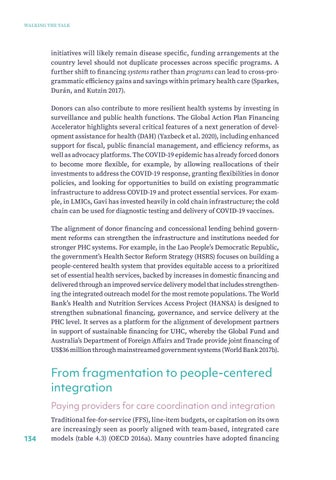WALKING THE TALK
initiatives will likely remain disease specific, funding arrangements at the country level should not duplicate processes across specific programs. A further shift to financing systems rather than programs can lead to cross-programmatic efficiency gains and savings within primary health care (Sparkes, Durán, and Kutzin 2017). Donors can also contribute to more resilient health systems by investing in surveillance and public health functions. The Global Action Plan Financing Accelerator highlights several critical features of a next generation of development assistance for health (DAH) (Yazbeck et al. 2020), including enhanced support for fiscal, public financial management, and efficiency reforms, as well as advocacy platforms. The COVID-19 epidemic has already forced donors to become more flexible, for example, by allowing reallocations of their investments to address the COVID-19 response, granting flexibilities in donor policies, and looking for opportunities to build on existing programmatic infrastructure to address COVID-19 and protect essential services. For example, in LMICs, Gavi has invested heavily in cold chain infrastructure; the cold chain can be used for diagnostic testing and delivery of COVID-19 vaccines. The alignment of donor financing and concessional lending behind government reforms can strengthen the infrastructure and institutions needed for stronger PHC systems. For example, in the Lao People’s Democratic Republic, the government’s Health Sector Reform Strategy (HSRS) focuses on building a people-centered health system that provides equitable access to a prioritized set of essential health services, backed by increases in domestic financing and delivered through an improved service delivery model that includes strengthening the integrated outreach model for the most remote populations. The World Bank’s Health and Nutrition Services Access Project (HANSA) is designed to strengthen subnational financing, governance, and service delivery at the PHC level. It serves as a platform for the alignment of development partners in support of sustainable financing for UHC, whereby the Global Fund and Australia’s Department of Foreign Affairs and Trade provide joint financing of US$36 million through mainstreamed government systems (World Bank 2017b).
From fragmentation to people-centered integration Paying providers for care coordination and integration
134
Traditional fee-for-service (FFS), line-item budgets, or capitation on its own are increasingly seen as poorly aligned with team-based, integrated care models (table 4.3) (OECD 2016a). Many countries have adopted financing


